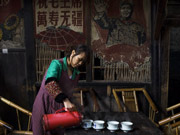

On Nov. 12, an exhibition of China’s opera figures paintings was opened in Shanghai. The exhibition remembers the 400th anniversary of the death of Chinese author Tang Xianzu.
Tang Xianzu (1550-1616), a celebrated playwright, whom fans call "China's William Shakespeare".
Tang, who lived in the same era as William Shakespeare, was an outstanding writer during the Ming Dynasty (1368-1644AD). His masterpieces are collectively called “Four Dreams,” since the protagonists’ respective dreamlands are key to the plots of each work.
"The Peony Pavilion," one of the Four Dreams and also Tang's most famous work, is renowned worldwide. It is also recognized for its ideological emancipation and anti-feudalism, representing Romanticism in Chinese literature. The work is traditionally performed onstage in the style of Kun opera.
Xie Chunyan, both an artist and chairman of China’s Opera Figure Painting Institute, explained that Tang pursued a romantic, spiritual realm, and criticized feudal society. These are the sentiments in Tang’s “Four Dreams.” The literary treasures that Tang left for future generations should be passed down and illustrated in various forms, including paintings, according to Xie.
The exhibition will remain open until Nov. 27. After its close, the paintings will be displayed in the city of Shaoxing, Zhejiang province from Dec. 2 to 18.
 |  |

 Who Will Fit The Chinese Roles In Game Of Thrones?
Who Will Fit The Chinese Roles In Game Of Thrones? China's Hubei Shennongjia added to World Heritage List
China's Hubei Shennongjia added to World Heritage List Cute Dog At Fruit Stand Becomes Latest Internet Sensation
Cute Dog At Fruit Stand Becomes Latest Internet Sensation Top 10 livable Chinese cities
Top 10 livable Chinese cities The last primitive tribe in China
The last primitive tribe in China China's first intelligent security robot debuts in Chongqing
China's first intelligent security robot debuts in Chongqing A Total of 3,552 Subscribers Vanish In Two Days; YouTube Closes All Doors to Users’ Inquiries
A Total of 3,552 Subscribers Vanish In Two Days; YouTube Closes All Doors to Users’ Inquiries Out of this world! Futuristic UFO-shaped yacht has its own garden and a stunning underwater viewing deck
Out of this world! Futuristic UFO-shaped yacht has its own garden and a stunning underwater viewing deck An old tea house in Chengdu
An old tea house in Chengdu Furious Customer Crushes All the Buns from Vendor Just Because He Was Given the Wrong Flavor
Furious Customer Crushes All the Buns from Vendor Just Because He Was Given the Wrong Flavor